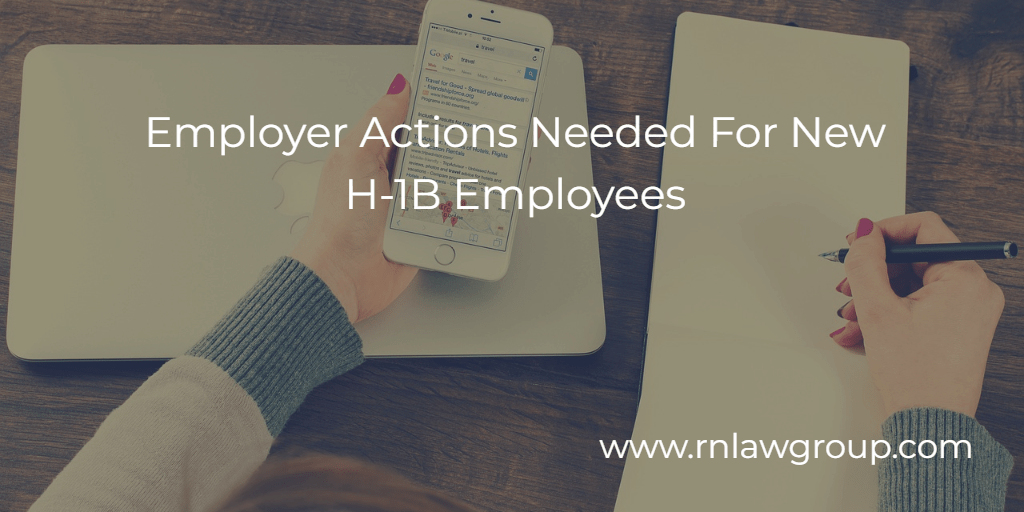
Employer Actions Needed for New H-1B Employees
As we are now into the new fiscal year which started on October 1, many companies are in the position of having employees that are either new hires on H-1B or are changing their status from another non-immigrant status to H-1B. With these changes brings about changes that employer’s HR team needs to be aware of so they can stay in compliance. With an increase in audits for proper compliance, it is important that companies are properly handling new employees on H-1B.
Confirm When H-1B Employment Can Begin
On October 1, many employees around the United States changed their visa status to H-1B. At times, this may lead to that person will be starting their first job with a corporation. However, in many cases, the individual is already employed by the company and will be converting their immigration status to H-1B from another immigration status, such as F-1, H-4 EAD, or L-1.
In practice, the first potential date for an employee to begin working on a new H-1B that was subject to the H-1B cap is October 1. This October 1st date, however, is not automatic. Before beginning work on H-1B status, the employee must have an authorized I-797 H-1B for your organization as well as a valid I-94. If the case was approved with an I-94, meaning the change of status was granted, the employee can begin working pursuant to H-1B status on the start date listed. If the case was not approved with an I-94, meaning the change of status was denied or not requested, the employee will have to go for visa stamping at a consulate abroad in order to “activate” their H-1B.
Wages and Other LCA Obligations
The first step of any H-1B is the filing of a Labor Condition Application (LCA) with the Department of Labor (DOL). This LCA comes with a number of attestations that the employer must comply with in order to avoid DOL scrutiny. The LCA attestations include that the company will:
- Pay the wage stated in the LCA, which must be at or above prevailing wage
- Pay for non-productive time
- Offer the same benefits package as available to US workers
- Provide proper working conditions similar to US workers
- Not employ foreign worker where a strike or lockout is occurring and notify DOL of any strikes in the future.
- Provide notice to the employee of the LCA and publicly post the LCA
Proper wage payment is one of the most important requirements that the corporation must meet, and is defined by the LCA. This salary may differ from what the company is currently paying the employee in their current position and is frequently higher. As soon as the person begins working for a company under H-1B status, payroll must be adjusted to account for the LCA compensation. Failure to pay wages in line with the LCA is a Department of Labor infraction that may result in legal problems for the employer.The wages must be paid “cash in hand” or free and clear. There are limited deductions that are allowed. A company is NOT allowed to impose a penalty or training fee, recoup H-1B expenses, or make the employee pay for ordinary business expenses. The company CAN make deductions required by law, deductions that are reasonable and customary (insurance, 401k, taxes), and any voluntary deductions the employee requests in writing.
In addition to the salary, the company must also offer H-1B workers with the same benefits as similarly employed US workers. Benefits include the ability to participate in company benefits such as health, life, disability, and other insurance plans, retirement and savings plans, cash bonuses, and non-monetary compensation such as stock options. If the corporation offers complete health care coverage, 401k matching, and stock options to US employees, it must equally offer it to similarly employed H-1B workers.
The LCA obligations and DOL regulations also put forth certain requirements if the company decides to terminate the employee. Termination of an H-1B employee is a three step process, called a “bona fide termination,” and employers are liable for wages until all three steps are taken. The company must notify USCIS of the termination, often by withdrawing the H-1B, the company must expressly notify the employee, preferably in writing, and the company must offer to pay for the return flight home for the employee. The company can set a reasonable amount of time to accept the offer to pay for the return trip home, say 10 days. The employee may not take the option to return home, but the company is still obligated to offer it.
In addition to complying with the LCA obligations, the company must also maintain proper records. Notably, the H-1B program and the LCA require a Public Access File. These are often audited by DOL and compliance is mandatory. More details about the Public Access File, or PAF, can be found here.
It is important to strictly adhere to the LCA obligations and DOL regulations. The DOL Wage and Hour Division has an enforcement branch for employees to utilize and seek back wages if the requirements are not being followed. More details about compliance with the H-1B LCA obligations can be found here.
I-9 Obligations
Companies must complete I-9 verification for all new employees within 3 business days of the date of hire, meaning the first day of work for pay. One of the common misconceptions for employers is that just because the employee changed to H-1B they have to do reverification right away. This is not the case. It is important to remember that the immigration action does not dictate an I-9 reverification.
Reverification of I-9 can only begin when the present job authorization document expires. For example, if a student holds an H-4 EAD that is valid through 05/01/2024 and changes status to H-1B on 10/1/2023, reverification is not required until 05/01/2024. When an employee converts their status to H-1B, this creates a difficult issue for the organization. If a company does it earlier, it may be considered discriminatory, which could be a problem. Companies must reverify employment authorizations ONLY when the current work authorization expires.
Update The Employee Tax Withholdings
Many employers seek a change of status from F-1 OPT to H-1B, and it is important to understand the tax implications of an employee changing from F-1 to H-1B. F-1 students have special income tax regulations and are exempt from paying Social Security and Medicare taxes on their earnings in the United States. However, this ends once the employee begins working on H-1B. Companies must be aware that they must alter their payroll to account for the change in status. When an employee switches status to H-1B, payroll must be changed to withhold money for Social Security and Medicare taxes as soon as the change is effective.
In conclusion, as employers navigate the complexities of hiring or changing the immigration status of employees to H-1B, it is crucial to adhere to the stringent legal requirements and obligations outlined by the Department of Labor (DOL) and USCIS. Compliance with these regulations is not only essential for avoiding legal troubles but also for ensuring fair treatment and proper documentation for your foreign-born workforce.
Navigating the intricate web of immigration regulations and employment laws can be a daunting task for employers. For any questions or concerns related to H-1B employee immigration issues, we strongly recommend contacting a qualified immigration attorney who can provide expert guidance and ensure that your organization remains in full compliance with the law. Seeking legal counsel can help protect both your employees and your company’s reputation in an ever-evolving immigration landscape.
Reddy Neumann Brown PC, located in Houston, Texas, has been serving the business community for over 25 years and is Houston’s largest immigration law firm focused solely on U.S. Employment-based immigration. We work with both employers and their employees, helping them navigate the immigration process quickly and cost-effectively.
By: Steven Brown
Steven Brown is a Partner at Reddy Neumann Brown PC where he works in the Non-immigrant visa department and leads the Litigation Team. His practice covers all phases of the non-immigration visa process including filing H-1B, L-1, E-3, H-4, and H-4 EAD petitions. In the last two years, Steven has successfully handled over 1,000 non-immigrant visa petitions including filing petitions, responding to any necessary Requests for Evidence, and drafting motions and appeals. He has also become a key resource for F-1 students that seek guidance on properly complying with the F-1 visa regulations and any OPT or CPT issues they may have. Additionally, Steven holds a weekly conference call for companies that are part of one of the largest organizations for IT Services companies in America.

